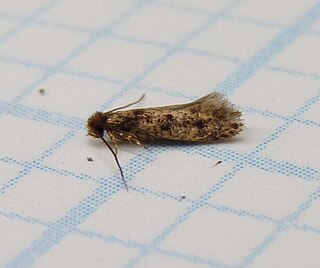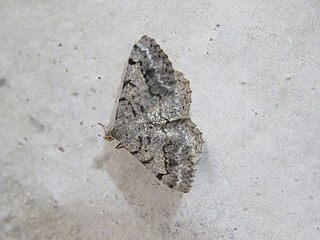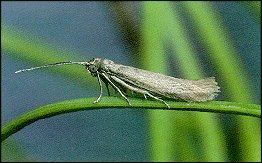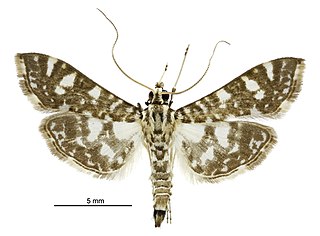
Neococytius is a monotypic moth genus in the family Sphingidae erected by Ronald W. Hodges in 1971. Its only species, Neococytius cluentius, the Cluentius sphinx, was first described by Pieter Cramer in 1775 as Sphinx cluentius. It is found in northern South America, Central America, Mexico and the Caribbean. It is rare on Cuba. It has been recorded in North America, from Mississippi north to Michigan and Illinois.
Haplonerita is a genus of moths in the family Erebidae. It was first described by Walter Rothschild in 1909. The genus was erected by George Hampson in 1911.

Phereoeca uterella, known by the vernacular names plaster bagworm and household casebearer, is a moth species in family Tineidae. It occurs in tropical climates, where it is common in houses, and is presumed native to the Neotropical realm. In the Americas, it has been recorded from Brazil, Guyana, and the southern United States as well as the Virgin Islands and Trinidad, and tentatively identified from Tobago.

Frederickia is a genus of moths in the family Geometridae described by Alexander Douglas Campbell Ferguson in 2008.

Acrobasis is a genus of moths of the family Pyralidae.

Coleophora laricella, the western larch case-bearer, is a moth belonging to the family of case-bearing moths Coleophoridae. It is native to Central and Northern Europe, with its original food source being the European larch or Larix decidua. However, it was introduced to North America in the mid-19th century where it has gained a wide range and become an invasive defoliater of several species of the genus Larix, particularly the western larch Larix occidentalis and the tamarack larch Larix laricina.
Praeacedes is a monotypic moth genus in the family Tineidae first described by Hans Georg Amsel in 1954. Its only species, Praeacedes atomosella, was first described by Francis Walker in 1863. It has a wide range and has been recorded from Europe, Australia, Hawaii, India, Malaysia, Solomon Islands, Easter Island, Mauritius, Madagascar, Réunion, South America and North America. The species has commonly been misidentified in various parts of the world.
Phereoeca allutella, the household case-bearing moth, belongs to the subfamily Tineinae of the fungus moth family (Tineidae). It was first described by Hans Rebel in 1892. It is an occasional pest of furs, flannel and similar materials, and has been inadvertently introduced to many places it is not originally native to.

Chabulina onychinalis, also known as the swan flower plant moth and until recently called Glyphodes onychinalis, is a moth of the family Crambidae. It is native to the Afro-Asian Region, including India, Sri Lanka, Hong Kong, Thailand, Indonesia, Japan, Australia and New Zealand, and has been recorded in California since 2000.
Coleophora kurokoi is a moth of the family Coleophoridae. It is found in Japan and China.
Coleophora honshuella is a moth of the family Coleophoridae. It is found on Honshu island in Japan and Korea.
Coleophora melanograpta is a moth of the family Coleophoridae. It is found in Japan and China.
Coleophora quercicola is a moth of the family Coleophoridae. It is found in Japan (Honshu) and South Korea.
Coleophora sinensis is a moth of the family Coleophoridae. It is found in Shanxi and Hebei provinces of China.
Coleophora majuscula is a moth of the family Coleophoridae. It is found in Azerbaijan.
Coleophora drymophila is a moth of the family Coleophoridae. It is found in Georgia and Azerbaijan.
Goniodoma auroguttella is a moth of the family Coleophoridae. It is found in southern Europe, European Russia and Asia Minor. The habitat consists of steppe and semi-desert biotopes.
Ahamus lijiangensis is a species of moth of the family Hepialidae. It was described by Hong-Fu Chu and Lin-Yao Wang in 1985 and is known from Yunnan, China.

iNaturalist is an American 501(c)(3) nonprofit social network of naturalists, citizen scientists, and biologists built on the concept of mapping and sharing observations of biodiversity across the globe. iNaturalist may be accessed via its website or from its mobile applications. iNaturalist includes an automated species identification tool, and users further assist each other in identifying organisms from photographs. As of 24 February 2024, iNaturalist users had contributed approximately 172,751,520 observations of plants, animals, fungi, and other organisms worldwide, and around 350,000 users were active in the previous 30 days.

The Tineinae are a subfamily of moths of the family Tineidae.








